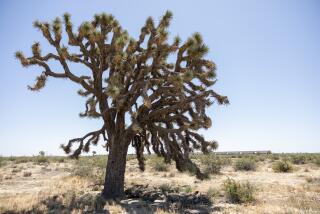THE MIRROR : How Others See Us : Desert Time
- Share via
The following, by Burton Bernstein, first appeared in The New Yorker. Reprinted by permission; 1986 Burton Bernstein.
Mojave is less than two hours by car over fine freeways from downtown Los Angeles, but it has about as much to do with that churning metropolis as Tonopah, Nevada, does. A boom-and-bust town of forty-two hundred people, Mojave lies on a gigantic plain as flat as your dining-room table, at the foothills of the Sierra Nevada Mountains. The hard-packed steppe, extending almost to the horizon in every direction, is a providential, practically ready-made airport, and, with three hundred and sixty days of thirty-mile-visibility flying weather every year in that spectacular high-desert region, it is no surprise that the military is a large presence. Edwards Air Force Base, whose dry-lake bed affords the longest runway in the Western world, is the home of the Air Force Flight Test Center and is the primary landing field for the space shuttles. . . . And yet Mojave has the look of a town that has seen better days, dating back to the glorious twenty-mule-team-borax-mining era of the eighteen-eighties. The contemporary houses, motels, and stores are on the Spartan, strictly functional side, and flinty, weathered faces of what seem to be unreconstructed gold prospectors abound. Hefty men hang about in the Pancake House and convenience stores, chatting in their Southwestern drawl about hunting and fishing; plain women cheerfully offer long answers to simple questions. Mojave is a desert crossroads town, its clear air filled with the roar of semis and the whistles of freight trains. Folks around those parts still tell the time of day by the Atchison, Topeka and the Santa Fe.
More to Read
Sign up for Essential California
The most important California stories and recommendations in your inbox every morning.
You may occasionally receive promotional content from the Los Angeles Times.












